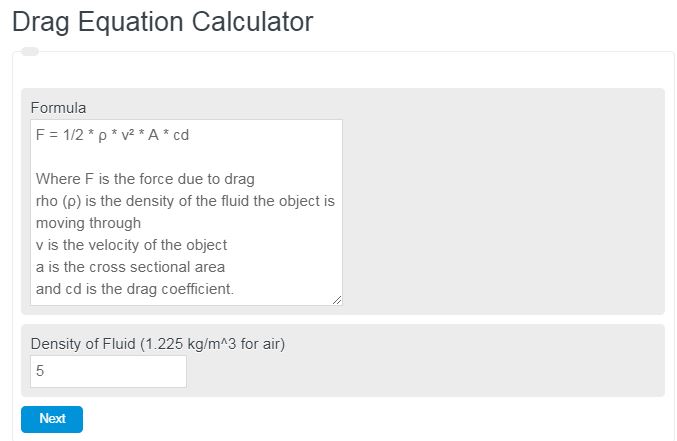Enter the density of the fluid (1.225 kg/m^3 for air), the speed, drag coefficient, and cross-sectional area of an object undergoing motion to calculate the force of drag (air resistance) on that object.
- Pressure Calculator
- Velocity Calculator
- Drag Coefficient Calculator
- Lift Force Calculator
- Sail Force Calculator
- Drag Per Unit Span Calculator
Drag Equation Formula
The following equation is used to calculate the drag force acting on a moving object through a fluid. Most often this fluid is air, but this formula can be used for any fluid.
F = 1/2 * ρ * v² * A * cd
- Where F is the force due to drag
- rho (ρ) is the density of the fluid the object is moving through
- v is the velocity of the object
- A is the cross-sectional area
- and cd is the drag coefficient.
The drag coefficient in this equation is almost always determined experimentally. There is computer software that can accurately estimate drag coefficients for simple objects, but for complex shapes is must be done experimentally.
Drag Equation Definition
The drag equation defines the total force acting on an object due to the resistance to motion on an object moving through a liquid.
How to calculate the force of drag?
How to calculate a force of drag
- First, determine the density of the fluid.
This is the density of the fluid the object is moving through.
- Next, determine the velocity.
Measure the velocity of the moving object.
- Next, determine the cross-sectional area.
This is the cross-sectional area of the object that is in contact with the liquid.
- Next, determine the drag coefficient.
Through empirical methods, determine the drag coefficient.
- Finally, calculate the force of drag.
Calculate the force of drag using the equation above.
FAQ
The drag equation describes the formula for calculating the force acting on an object that is moving through a liquid.

